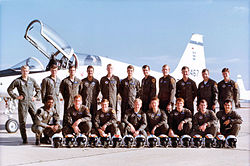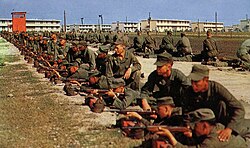Air Training Command
| Air Training Command | |
|---|---|
 Undergraduate Pilot Training Class photo, Class 81-05, Reese AFB, Texas, c. 1981  Vietnam War Basic Training on the M-1 carbine Dry Fire range, Lackland AFB, Texas, 1960s  Entrance sign to Lowry AFB Technical Training Center, Colorado, about 1957 |
|
| Active | 1946–1993 |
| Country |
|
| Branch |
|
| Type | Major Command |
| Role | Air Force Basic, Flight and Technical training |
| Garrison/HQ | Randolph Air Force Base, Texas |
| Nickname(s) | ATC |
| Decorations |
Air Force Organizational Excellence Award (9x) |
| Insignia | |
| Emblem of Air Training Command |  |
Air Training Command (ATC) is a former United States Air Force (USAF) Major Command designation. It was headquartered at Randolph Air Force Base, Texas, but was initially formed at Barksdale Air Force Base, Louisiana. It was re-designated as Air Education and Training Command (AETC) following a merger with Air University (AU) on 1 July 1993.
ATC was organized on 1 July 1946 as a re-designation of Army Air Forces Training Command (AAFTC) as part of the re-organization of the United States Army Air Forces (USAAF) after World War II.
For nearly 50 years, ATC was the primary training organization of the United States Air Force from its inception as an independent service in September 1947. It provided pilot and aircrew training; technical training, and enlisted and officer basic training.
At the end of the Cold War, it was merged with Air University (AU) in July 1993 as part of a major top-to-bottom reorganization of the USAF. Personnel, equipment and resources of both organizations were re-designated as Air Education and Training Command (AETC), which assumed the mission of both organizations, but retained AU as a subordinate organization within AETC.
On 1 July 1946, Army Air Forces Training Command was re-designated as Air Training Command (ATC). Since the end of World War II in September 1945, AAF Training Command had been undergoing rapid contraction, actually begun earlier in 1945 as planners understood the changing forces of the war against Nazi Germany, which ended in May 1945. Excess training bases across the United States had begun to be shut down and units consolidated during the summer of 1945 as the training needs of the USAAF was being refocused to support the requirements of those USAAF combat units in the war against Imperial Japan. The Atomic bombings of Hiroshima and Nagasaki in August 1945 and the end of the war in the Pacific in September 1945 began a rapid demobilization of the U.S. armed forces. Large numbers of temporary training bases were closed and units were discontinued in late 1945 and early 1946 as the US military transitioned from a wartime footing to a peacetime one.
...
Wikipedia
